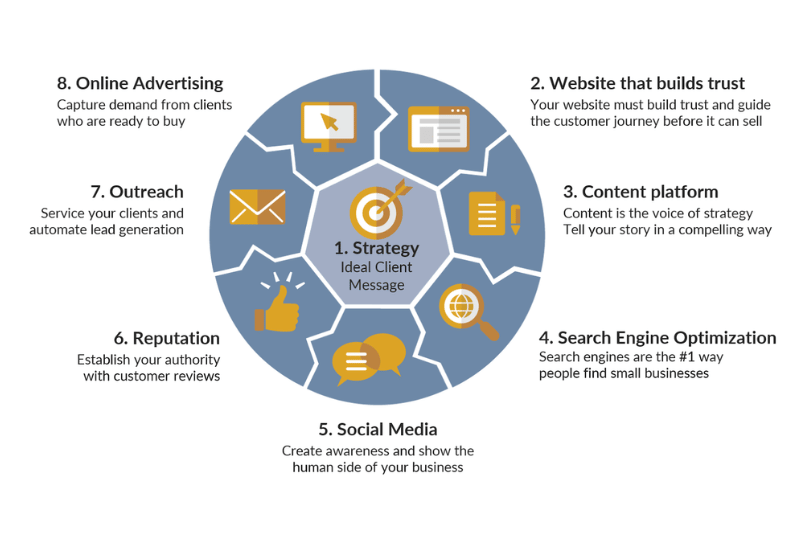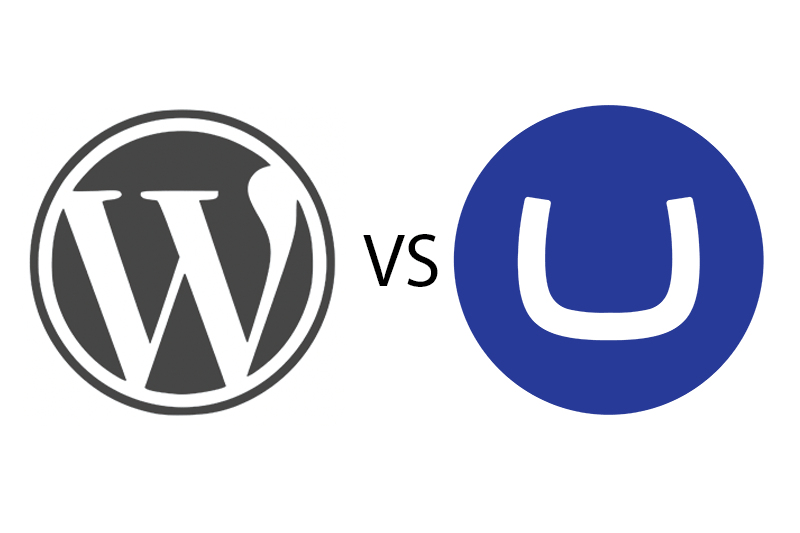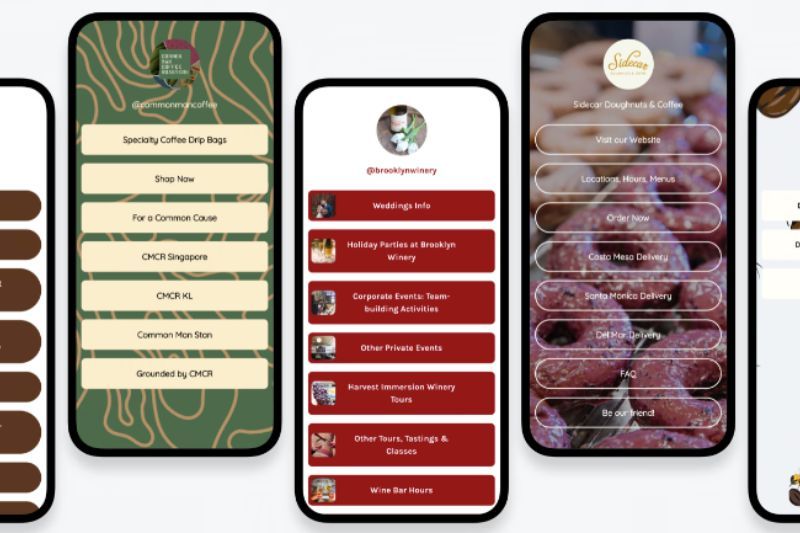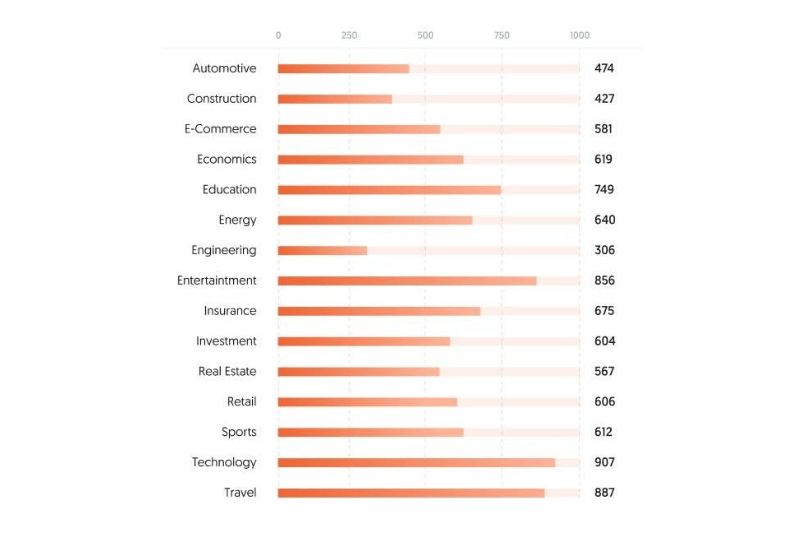How to Write Excellent Content for Your Website
The competition is real when it comes to fighting for search engine results and traffic online. Unfortunately, readers typically only spend seconds glancing at the web content before deciding whether to stay or move on, which is why writing excellent text is crucial.
Following the advice we’ve laid out will help you develop interesting, well-thought-out, and quality content and website copy. We will help you engage with your readers and leave them wanting more.

Tips for Writing Website Content
There are numerous things to consider when writing content for a website. While many of the most common rules of writing still apply (i.e., grammar, spelling, etc.), there are other web-writing rules to consider before hitting those keys. Here are some web content writing tips to follow for your web page.
Start by Telling a Story
Telling a story through your writing will help engage visitors and keep them interested in your content. Take readers on an adventure with structured quality content curated to their interests and needs.
Using tools like
Storybrand, you can reach online customers through clear messages and successful marketing skills.
Be Confident
Always speak with confidence and authority in your writing. There is no shame in knowing your stuff and using your expertise to prove it.
To convince your readers you know what you are talking about, you should steer clear of words like just, maybe, possibly, think, etc. These words will make you sound unsure of yourself and the information you are offering.
Be Interesting
If readers wanted to be bored, they would head to an encyclopedia for answers to their questions. So keep your content creation interesting and informative.
Offer visitors good content that will answer all their questions while engaging and entertaining them so they keep coming back. You can make your site interesting by adding fun facts, quotes, graphs, etc.
Use “We,” Not “Me”
Only talk about yourself when creating website or blog content if you are explicitly talking about a personal experience.
Saying “I like” or “I can” sounds selfish and makes the information about you. If you say “We like” or “We can,” it includes the website visitor in the conversation and keeps them interested in what you have to say.
Keep Things Short and Sweet (Answer Questions Directly and Honestly)
Keep your information short and get straight to the point. Most people prefer to scan data to locate answers to their questions quickly. No one is looking to read a book in their search results.
No matter what the question is, answer it straight away and answer it honestly. This approach is the core of the
“They ask, you answer” business framework.
You will also benefit from keeping your words easy to understand; visitors to your site will appreciate not needing a dictionary.
Avoid Fluff
In the writing world, the word “fluff” describes useless filler words added to short sentences to help reach the intended word count.
All of your sentences should contain natural, helpful, and informational content. Filler words make articles boring and can be confusing to the reader.
Link to Reputable Sources
Linking to other websites can benefit your writing. Not only does it help keep traffic flowing throughout the web, but it is a great way to create SEO content.
However, just because you read it online doesn’t mean it is always true. Be careful where you get your information; only link to reputable and reliable sources.
Internal hyperlinks are another helpful tool when writing content for a website. This can help readers view more of your content quickly and easily.
Although we recommend using external and internal links, be careful not to overdo it. Three to four quality sources are a good amount without overwhelming the reader.

The Best Structure for Writing Website Content
The structure will make your website more appealing to your target audience. Having the proper setup when writing content will help visitors find what they are looking for with the ability to skim over the rest.
Listed below are a few of the best tips for writing website content with beneficial structuring.
Create a Catchy Headline or Title
The old saying goes, “Never judge a book by its cover.” However, in this fast-paced day and age, we all do it. People will decide whether they want to read your web content simply based on your chosen title.
Every title you pick needs to be catchy and exciting. The titles also have to provide relevant keywords and a quick glimpse into what the article is about.
- “How to Sew.” Boring.
- “Step-by-Step Guide to Sewing With Style.” Gives information regarding what is in the article and makes readers want to dive in.
Another tip to impressive titles is offering a specific number to focus on.
- “Great Cookie Recipes.” Boring.
- “5 Delicious Cookie Recipes You Have to Try.” This lets the reader know they have options to choose from and sounds exciting.
Make that First Paragraph Count (Follow the Pyramid Structure)
The first paragraph of your fresh content has to get right to the point. The reader wants an answer to their questions immediately; no one wants to search for it.
It is always best to offer direct answers and pertinent information in the first paragraph, then add essential details as you continue.
If your content answers a direct question, “Can Pet Hedgehogs Eat Fruit?”, your first paragraph needs to answer the question.
“Your pet hedgehog can eat fruit. Apples, blueberries, and bananas are some of the best options. However, too much fruit can lead to health issues and shouldn’t be given frequently.”
Here you answered the questions and grabbed the reader's attention, encouraging them to keep reading to get more in-depth answers.
Use Built-in Headings and Subheadings
Headings and subheadings help structure content writing and organize your thoughts and information.
The titles to subheadings should continue the same theme throughout your content while providing their own information.
Now that we answered the direct question in the first paragraph, we can move on to explain it in greater detail.
- Subheading 2: Can You Feed a Pet Hedgehog Fruit?
- Subheading 3: What Fruits Are Safe for Pet Hedgehogs?
- Subheading 3: What Fruits Are Not Safe for Pet Hedgehogs?
- Subheading 2: How Much Fruit Can You Feed Your Pet Hedgehog?
- Subhea ding 3: How to Tell Your Feeding Your Hedgehog too Much Fruit
Keep Paragraphs Short
Always keep your paragraphs short, at most three to four sentences long. This will help the reader browse your fresh content quickly.
Short paragraphs also benefit people who look at your website from their phones. Long paragraphs create large blocks of text on mobile devices; no one will want to scroll through it all to find what they’re looking for.
Avoid Run-On Sentences
Run-on sentences (for those of you who don’t know) are sentences that combine multiple sentences without the correct punctuation.
When writing website content, commas, semi-colons, or conjunctions are your best friend. These punctuations will help separate thoughts in a single sentence without running together.
Examples:
- “We like rain we don’t like thunderstorms.”- Incorrect. This is a run-on sentence.
- “We like rain, but we don’t like thunderstorms.” The correct way to write this sentence.
- “We like rain; we don’t like thunderstorms.” Another correct way to write this sentence.
Online writing tools such as
Grammarly and
Hemingway
can ensure your sentences are clear and correct.
Keep Your Thoughts Organized
Before writing content for your website, take a few minutes to organize your thoughts and create a plan.
It is easier to create great content when you know which direction you are going in and the proper steps to take to get there.
Developing an outline depicting the most important information and where it should go on your website can be beneficial.
If you are writing a blog post, creating a structure by preplanning your headings and subheadings can make all the difference in the world.
Only Use Half the Normal Amount of Text
If browsers wanted to read a book, they would head to the library. People come to your website for helpful information and hope to get it instantly.
Website content is where the 50% rule comes in. Only write 50% of the text you usually would when writing. This will help keep your audience engaged and assist in getting your point across and well-received.
Delegate One Thought to Each Paragraph
Every single word used in your content writing has to offer value to the reader. You can easily accomplish this by delegating your thoughts to separate paragraphs.
Remember, we are all scanners these days, meaning we skip over long paragraphs to try to locate information quickly.
If you notice some of your content is running on too long, simply split the sentences into two separate paragraphs.
Make Important Information Stand Out
Why should we highlight important information? You guessed it! Because readers want answers fast.
Offer your visitors the ability to quickly scan through text to get straight to the point by using:
- Highlighting
- Bullet points
- Bold keywords or phrases
- Graphs and charts
Example 1:
“To make chicken noodle soup, you need chicken broth, egg noodles, cooked chicken breast, fresh vegetables, salt, and pepper.”
Example 2:
Chicken noodle soup ingredients:
- Chicken broth
- Egg noodles
- Cooked chicken breast
- Fresh vegetables
- Salt and pepper
In the two examples above, which one grabs your attention first? Example two is easier to find, read, and understand.
Know Your Audience

While we all want to reach the largest audience possible, knowing
who visits your site the most or will benefit from your content is vital.
Take a moment to identify who your primary and secondary audience is and the best way to reach them.
If your website is all about mindfulness, affirmations, and meditation, it isn’t going to look the same as an
online portfolio.
The website on self-care will bring in others interested in this specific topic and looking to learn from your content.
The people tuning in to see your portfolio are looking for a professional website with services they can benefit from.
Both sites need to be informative, well-written, and organized, but you should present the content in entirely different ways.
Check in with Social Media
There are so many social media platforms available today; it would be a shame not to utilize them for your own gain.
You can use social media sites to get some insight into what your target audience is looking for and the trending topics in that niche.
Social media sites are also ideal for
content marketing and bringing new traffic to your website. Word of mouth spreads fast!
You can also team up with social media platforms, providing content and snip-its on Facebook, Instagram, etc., then referring them to your site for more information.
Use a Tracker
Before diving into your content, use tracking software to see what current visitors are doing on your website.
These programs can help you see what content is beneficial and should be rewritten or tossed entirely.
Information is constantly updated, and you have to stay on top of trends, updated data, statistics, etc.
Organize Your Page
Typing text is only half the battle when writing content for a website; the other half is organizing your page so visitors are likely to crave more.
Use the White Space
The empty space between blocks of text, photos, and other content in your website design is called white space. Many people try to fill this space as much as possible, but that isn’t necessary.
White space is easy on the eyes and helps readers scan through text more quickly. Sometimes less is more when writing content or blog posts for a website.
Infuse Your Text with Multimedia Content
Many people obtain information visually through pictures and charts more quickly than through text. Knowing this, you should offer multimedia content to reach your audience.
Detailed charts and graphs can help readers digest more complicated topics. They can also assist in breaking up text, making it easier to get through.
Most expert content writers suggest using at least one photo for each page and multiple photos for longer blogs, articles, and information.
Call to Action
Remember to add your call to action in your content writing. This step is crucial no matter what niche you are in.
A call to action encourages the reader to “act now.” You typically want to add your call to action at the end of the content, and make it exciting and urgent.
Examples of a CTA:
- “Call now for a free consultation; operators are standing by.”
- “Limited time offer. Call XXX for 15% off.”
- “If you struggle to fall asleep at night, you must try one of the bedtime meditation techniques listed above.”
Final Thoughts
You don’t have to be an expert content writer to create high quality content for your website. Using the tips provided above can help you grab the attention of readers and help increase traffic to your website.
Do you have any questions on the above, or would you like to share your experience? Just email ideas@mawazo.ca or call +1 (833) 503-0807.
At Mawazo Marketing we work with owners of B2B companies who want to accelerate their business. We help them with a concrete digital growth plan, a website that saves operational cost, and a digital marketing system that generates leads. For qualifying clients we offer a 5x ROI guarantee: if we don't reach the objective, then we pay back the difference. Book a Free Strategy Session to find out more.












